Did you know that Truthout is a nonprofit and independently funded by readers like you? If you value what we do, please support our work with a donation.
Do you support Truthout’s reporting and analysis? Click here to help fund it this week!
 Students and teachers from community colleges, state university campuses and campuses of the University of California marched in Sacramento to oppose cuts to state funding for education. They called for support for the millionaires’ tax to make up for drastic shortfalls in the state budget. Pictured: Dina Elattar. (Photo: David Bacon)Today, California community colleges charge $36/unit, a fee due to increase to $46 this summer. Those fees have been the subject of strong criticism by students and the California Federation of Teachers since they began rising as a result of the state’s fiscal crisis. Union leaders and students have shown that, as they increase, the number of students able to afford community college decreases.
Students and teachers from community colleges, state university campuses and campuses of the University of California marched in Sacramento to oppose cuts to state funding for education. They called for support for the millionaires’ tax to make up for drastic shortfalls in the state budget. Pictured: Dina Elattar. (Photo: David Bacon)Today, California community colleges charge $36/unit, a fee due to increase to $46 this summer. Those fees have been the subject of strong criticism by students and the California Federation of Teachers since they began rising as a result of the state’s fiscal crisis. Union leaders and students have shown that, as they increase, the number of students able to afford community college decreases.
Under the impact of the economic crisis, Santa Monica College has cut back over 1,000 classes in recent years. Its current funding from the state was reduced by $11 million this year, and it may lose an additional $5 million next year.
On April 3, as the board was debating a proposal from district President Chui Tsang to institute a system charging much higher fees for some of the classes offered by the community college, thirty students and a four-year-old girl were pepper sprayed outside the meeting room.
While it wasn’t what she expected when she was elected to the Board of Trustees of Santa Monica College, it wasn’t a surprise to Margaret Quiñones-Perez. She called it “a wakeup call to us as an institution that we needed to have a bigger conversation … We had to stop and look and see what was going on.”
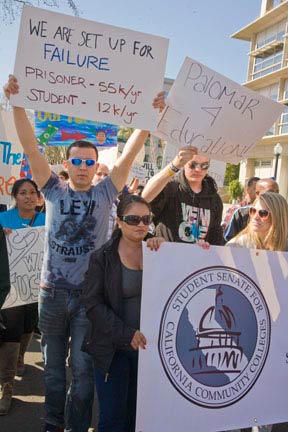 (Photo: David Bacon)Starting last year, Tsang proposed that the 34,000-student college create a nonprofit foundation that would offer core classes, such as English and math, but charge as much as $200 per unit. He predicted that despite state reductions, the college could actually increase offerings if it began charging a much higher fee for additional sections of the most popular classes, once the first set of classes offered at lower fees was filled. Some district officials even predicted that the coming winter session might offer only the higher fee classes.
(Photo: David Bacon)Starting last year, Tsang proposed that the 34,000-student college create a nonprofit foundation that would offer core classes, such as English and math, but charge as much as $200 per unit. He predicted that despite state reductions, the college could actually increase offerings if it began charging a much higher fee for additional sections of the most popular classes, once the first set of classes offered at lower fees was filled. Some district officials even predicted that the coming winter session might offer only the higher fee classes.
Tsang and other supporters of the idea first tried to convince legislators to pass a bill, AB 515, which would allow the change. Such legislation would be needed, most believe, because current state regulations prohibit a two-tier fee scheme. Paul Feist, a spokesman for California Community Colleges Chancellor Jack Scott, has held that higher fees can only be charged for contract courses geared to the needs of specific employers. In general, he said, state law prohibits higher fees for normal, core classes.
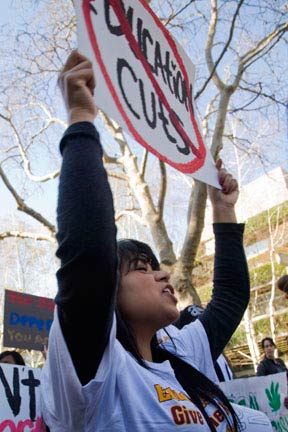 (Photo: David Bacon)The bill failed in committee, however. Then, Tsang came to a Santa Monica Board of Trustees retreat. “I said that I didn’t think it was proper to introduce this proposal in a meeting that wasn’t public,” Quiñones-Perez recalled. “He slipped it in anyway. I felt this was very disrespectful, and a real problem because he was trying to get board members’ agreement in a meeting that was not a public venue. The public anger and frustration when it finally came out was predictable.”
(Photo: David Bacon)The bill failed in committee, however. Then, Tsang came to a Santa Monica Board of Trustees retreat. “I said that I didn’t think it was proper to introduce this proposal in a meeting that wasn’t public,” Quiñones-Perez recalled. “He slipped it in anyway. I felt this was very disrespectful, and a real problem because he was trying to get board members’ agreement in a meeting that was not a public venue. The public anger and frustration when it finally came out was predictable.”
That happened on April 3, when a hundred students marched from the campus library to a board meeting, chanting, “No cuts, no fees; education should be free!” When they arrived, they found the meeting was taking place in a room that couldn’t accommodate a large crowd, and that people were being given numbers to gain admittance. As students massed at the doorway, the chanting changed to, “Let us in; let us in!” Campus security then pepper sprayed the crowd and manhandled some of the students. About thirty students suffered the chemical’s effects, and two were taken to the hospital.
Afterward, Tsang blamed the students. “Although a number of participants at the meeting engaged in unlawful conduct, Santa Monica College police personnel exercised restraint,” he asserted later in a statement. “Santa Monica College regrets that a group of people chose to disrupt a public meeting in an unlawful manner.”
“It’s a strange time we are living in when people who are outraged by social injustice and the lack of democracy in our schools and society are seen as the crazy ones,” responded Harrison Wills, student body president, in an Internet comment. He wondered “how incredibly important decisions are made without our consultation and to top it off in an extremely small room for a school of 35,000 students.”
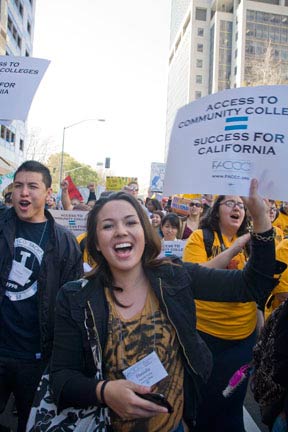 (Photo: David Bacon)The real problem, explained Quiñones-Perez, who, with student trustee Joshua Scuteri, were the only votes against the proposal, is that it creates a two-tier educational system in community colleges. These were the most important guarantors of the promise in California’s Master Plan that higher education would be available to every student who wanted it. “It really creates segregation instead,” she said, “between the haves and the have-nots. If you can pay, you’ll get your classes. That’s guaranteed if you have money. But if you don’t have money, you may get classes, and you may not. Community colleges were not created for this.”
(Photo: David Bacon)The real problem, explained Quiñones-Perez, who, with student trustee Joshua Scuteri, were the only votes against the proposal, is that it creates a two-tier educational system in community colleges. These were the most important guarantors of the promise in California’s Master Plan that higher education would be available to every student who wanted it. “It really creates segregation instead,” she said, “between the haves and the have-nots. If you can pay, you’ll get your classes. That’s guaranteed if you have money. But if you don’t have money, you may get classes, and you may not. Community colleges were not created for this.”
Skyrocketing fees in the state university and University of California systems have already frayed the Master Plan badly. UC Berkeley has turned away thousands of in-state applicants, who have been replaced by affluent students paying out-of-state fees making UCB more expensive than Yale and Princeton. About 30 percent of the incoming freshman class of 2011 now pay out-of-state fees that are $23,000 a year more than those for in-state students.
Some Santa Monica College board members call Tsang’s proposal innovative. “They say the Master Plan is outdated, not in tune with financial reality and what’s feasible,” Quiñones-Perez charged. “But you don’t get to change the values of what community colleges are supposed to do. Only the people of California get to do that.” In response to Tsang’s assertion that the change is necessary, and that students will either have to pay even more to private college operators or go without classes entirely, she responded that “we have to be able to weather the current fiscal storm, work with legislators, even scale back some. But I’ve been on this board for eight years, and the Santa Monica school board for 12 years before that, and we’ve had peaks and valleys in funding all that time. We will straighten this out as a state, and we may have to wait, and we may have to see some pain, but it will be an equalized pain and an equalized solution.”
 (Photo: David Bacon)For Quiñones-Perez, defending the Master Plan is second nature. Its guarantees enabled her to get an education that would otherwise have been far out of reach. She grew up in Stoner Park, a poor enclave in the middle-class neighborhoods of west Los Angeles. “My dad came to the U.S. when there were tobacco and onion fields in the area. You could still see the shacks farm workers lived in on Olympic Boulevard and Sawtelle when I was growing up. That’s where he met my mom, who was born here. They met in The Lucky U bar – the local hangout where Latinos of their generation went to socialize.”
(Photo: David Bacon)For Quiñones-Perez, defending the Master Plan is second nature. Its guarantees enabled her to get an education that would otherwise have been far out of reach. She grew up in Stoner Park, a poor enclave in the middle-class neighborhoods of west Los Angeles. “My dad came to the U.S. when there were tobacco and onion fields in the area. You could still see the shacks farm workers lived in on Olympic Boulevard and Sawtelle when I was growing up. That’s where he met my mom, who was born here. They met in The Lucky U bar – the local hangout where Latinos of their generation went to socialize.”
Quiñones-Perez was the middle child of nine brothers and sisters, seven of whom survived to adulthood. Then, her father returned to Mexico, where he was killed in a horrific car accident. That left her mom to support the family.
“She found us a cheap house in a safe neighborhood, away from the gangs of Venice, where my older brother was killed,” Quiñones-Perez remembered. “She worked as a domestic, and by the time I was eight, I was going to work with her. At first I thought it was exciting. I was in big houses, with pretty things I’d never seen before. But soon I felt humiliated, washing the bathroom on my knees. I was embarrassed and ashamed. I didn’t understand why I had to clean other peoples’ bathrooms. When I saw the drapes and carpets in those homes, I knew I was poor.”
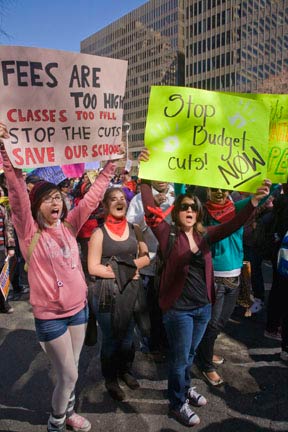 (Photo: David Bacon)In addition, she also began to realize what it meant to be Mexican in LA. Like many of her generation, her mother had been punished in school for speaking Spanish. Although young Margaret spoke Spanish at home, her mother pushed her to speak English out in the world. “In the quietness of my mind,” she recalled, “I knew that if I’d had blonde hair and blue eyes, life would have been better for us. It’s not that I didn’t want to be Mexican, but I knew that if you weren’t, you’d have better food and a better life. So there we were, cleaning houses and getting food stamps. In back of Safeway I’d meet Sam, a clerk who’d give us crates of loose grapes and bruised fruit – what they were throwing away. For us, that was a treat, like Christmas. My mom would go to the bakery outlets for the day old bread and cupcakes. We learned to appreciate the little things.”
(Photo: David Bacon)In addition, she also began to realize what it meant to be Mexican in LA. Like many of her generation, her mother had been punished in school for speaking Spanish. Although young Margaret spoke Spanish at home, her mother pushed her to speak English out in the world. “In the quietness of my mind,” she recalled, “I knew that if I’d had blonde hair and blue eyes, life would have been better for us. It’s not that I didn’t want to be Mexican, but I knew that if you weren’t, you’d have better food and a better life. So there we were, cleaning houses and getting food stamps. In back of Safeway I’d meet Sam, a clerk who’d give us crates of loose grapes and bruised fruit – what they were throwing away. For us, that was a treat, like Christmas. My mom would go to the bakery outlets for the day old bread and cupcakes. We learned to appreciate the little things.”
In school, Quiñones-Perez faced another barrier. She had auditory problems, and in first grade, her mother signed the papers sending her on the bus to special education classes. “In those days they didn’t have separate classes for the blind, or the emotionally disturbed or physically disabled. We were all lumped together. And for the next twelve years, that’s how I went to school.”
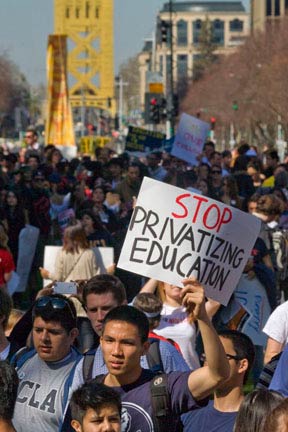 (Photo: David Bacon)Nevertheless, she graduated from high school, the first in her family and only one of her siblings who did. “It was a hard childhood, but it made me a principled person. I know right from wrong, I’m very loyal, and I know how to work hard. But I was taught to hide my disability, and that I was stupid.” That lasted even when she enrolled in Santa Monica College, where she got all C’s.
(Photo: David Bacon)Nevertheless, she graduated from high school, the first in her family and only one of her siblings who did. “It was a hard childhood, but it made me a principled person. I know right from wrong, I’m very loyal, and I know how to work hard. But I was taught to hide my disability, and that I was stupid.” That lasted even when she enrolled in Santa Monica College, where she got all C’s.
But at Santa Monica, she discovered the student organization MEChA – the Movimiento Estudantil Chicano de Aztlan. The other students talked to her about going on to a four-year school, and in the meetings, she got her first exposure to Chicano history and art. “I learned who I really was,” she said, “a Chicana, a woman of Mexican descent. It gave me a better image of myself. I wasn’t hiding anymore.”
When she got to Cal State Dominguez Hills, she stopped hiding her disability also. A statistics teacher, Barry Rosen, immediately recognized her problem and helped her find an educational path that played to her strengths. She got married, had children, got separated, and finally completed her BA with the help of the school’s childcare and financial aid programs. With a stipend from the Minority and Research Careers program, she became a mental health researcher, which prepared her for the job she’s had ever since – counselor at El Camino College. She eventually got a masters’ degree at the University of Southern California, and a doctorate at UCLA.
At El Camino she joined the union right away. “I’ve always been a unionista,” she laughed. Today, she’s first vice president of the El Camino Federation of Teachers, AFT Local 1388, and its political action chair. She mobilizes members for initiatives like the current tax reform, while working with local reps. “We’ve got very ugly negotiations going on now, and the district has imposed a contract on us, so we’re likely to have some job actions. But I’ve learned over the years that if you don’t raise your voice, nothing will every happen.”
For 22 years at El Camino, she was also a single parent, making it necessary to get additional part-time counseling jobs at Cerritos and Santa Monica Colleges and in migrant education programs. “But I never left El Camino,” she emphasized. “A job there was security for my children – a paycheck and healthcare.” She discovered that her children had learning disabilities, just as she’d had. That made her a fighter for them, and other students like them.
When they became students in Santa Monica, she ran for the board of education of the Santa Monica Malibu Unified School District, and served there 12 years. “No one knew my kids were at Unified. But I knew that if I wasn’t fighting for them and other students of color, the system would fail them. There’s a stigma to special ed that makes kids feel vulnerable and different. I wanted them to feel they could do anything.”
After they’d graduated, she ran for the college district board and won. She looks at the students from the Pico neighborhood, the poor barrio of Santa Monica, and thinks, “We can do better for them.” That’s one reason why Tsang’s proposal makes her angry. “They just want to create more classes and sell them at a time when we aren’t looking at the impact on the students who need us the most. What’s the retention rate for kids of color? What are we doing to get them through?”
Quiñones-Perez is proud of Santa Monica College. “We have a wonderful reputation and a great faculty. Some students take two or three buses from a long ways away just to come here, because they believe it will help them get to a four-year school. But I fear that if they’re coming from poor communities, they’ll get locked out.”
That’s clearly a fear she shares with the students who were pepper sprayed as they tried to get into the meeting where the decision on their future was hanging in the balance.
This article may not be reprinted without permission of the Author.
Matching Opportunity Extended: Please support Truthout today!
Our end-of-year fundraiser is over, but our donation matching opportunity has been extended! All donations to Truthout will be matched dollar for dollar for a limited time.
Your one-time gift today will be matched immediately. Your monthly donation will be matched for the whole first year, doubling your impact.
This matching gift comes at a critical time. As Trump attempts to silence dissenting voices and oppositional nonprofits, reader support is our best defense against the right-wing agenda.
Help Truthout confront Trump’s fascism in 2026, and have your donation matched now!
